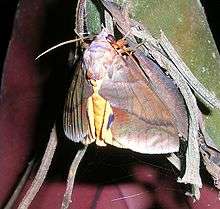Eudocima phalonia
| Common fruit-piercing moth | |
|---|---|
 | |
| Male (India) | |
| Scientific classification | |
| Kingdom: | Animalia |
| Phylum: | Arthropoda |
| Class: | Insecta |
| Order: | Lepidoptera |
| Family: | Erebidae |
| Tribe: | Ophiderini |
| Genus: | Eudocima |
| Species: | E. phalonia |
| Binomial name | |
| Eudocima phalonia (Linnaeus, 1763) | |
| Synonyms | |
| |
The Common fruit-piercing moth, (Eudocima phalonia), is a fruit piercing moth of the family Erebidae. It is found in large parts of the tropics, mainly in Asia, Africa and Australia but introduced into other areas such as Hawaii, New Zealand and the Society Islands. It is one of major fruit pests in the world.[1]
Description
The wingspan is about 80–94 mm in male. Palpi with third joint long and spatulate at extremity. Fore wings with non-crenulate cilia in male, crenulate in female. Head and thorax reddish brown with plum-color suffusion. Abdomen orange. Fore wings reddish brown, usually with a greenish tinge and irrorated with dark specks. An oblique antemedial line present, which is generally dark and indistinct but sometimes pale and prominent. Reniform indistinct. A curve postmedial line found, which is almost always met by an oblique streak from apex. Hind wings orange, with a large black lunule beyond lower angle of cell. There is a marginal black band with cilia pale spots runs from costa to vein 2. Ventral side of fore wings with orange postmedial band.[2]
The wingspan is about 90–110 mm in female. Female has much more variegated and dark reddish brown striated fore wings. Reniform dark and sending a spur along median nervure to below the orbicular speck. There is a triangular white mark usually present on the postmedial line below vein 3.[3]
Larva has dilated 11th somite and surrounded by a tubercle. Body purplish brown, where dorsum brown from 6th to 11th somites. Legs red and spiracular scarlet patches largest posteriorly and with some irregular white markings round them, on somite 9 in the form of an oblique white bar. There is a yellow sub-basal mark found on 4th somite. Fifth and sixth somites have black ocelli with yellow iris and white pupils. Two yellow patches can be seen on 11th somite.[3]
The adult is considered an agricultural pest, causing damage to many fruit crops by piercing it with its strong proboscis in order to suck the juice. Attempts have been made to control them using baits for the adults,[4] egg parasites and larval parasitoids.[5]
Ecology
The larvae feed mainly on vines belonging to the Menispermaceae but have also adapted to species of Erythrina[6] and are known to feed on Erythrina crista-galli, Erythrina fusca, Erythrina variegata, Carronia multisepala, Hypserpa decumbens, Legnephora moorei, Pleogyne australis, Sarcopetalum harveyanum, Stephania aculeata, Stephania forsteri, Stephania japonica and Tinospora smilacina.[7]
Infected plant parts are mostly the fruits. Fruits show sap ooze out and internal feeding of the caterpillar. Fruits may show premature drop. Adults penetrate the skin or rind with a strong, barbed proboscis. Damaged parts become spongy and with many lesions.[8]
Gallery
 Male
Male Female
Female Female, dorsal view
Female, dorsal view Female, ventral view
Female, ventral view Male, dorsal view
Male, dorsal view Male, ventral view
Male, ventral view Larva
Larva Pupa
Pupa
References
- ↑ "Eudocima phalonia (Linnaeus)". ICAR-National Bureau of Agricultural Insect Resources. Retrieved 18 August 2016.
- ↑ Hampson G. F. (1892). "The Fauna Of British India Including Ceylon And Burma Moths Vol-ii". Digital Library of India. p. 558. Retrieved 4 July 2016.
- 1 2 "Eudocima [Othreis] phalonia Linnaeus [fullonia Clerck]". The Moths of Borneo. Retrieved 18 August 2016.
- ↑ Reddy, G.V.P.; Cruz, Z.T.; Muniappan, R (2007). "Attraction of fruit-piercing moth Eudocima phalonia (Lepidoptera: Noctuidae) to different fruit baits". Crop Protection. 26 (4): 664–667. doi:10.1016/j.cropro.2006.06.004.
- ↑ Sands, D.P.A.; Liebregts, W.J.M.M.; Broe, R.J. (1992). "Biological control of the fruit piercing moth, Othreis fullonia (Clerck) (Lepidoptera: Noctuidae) in the Pacific". Biological Control of Exotic Pests in the Pacific, XIX International Congress of Entomology, June 1992, Beijing.
- ↑ Reddy GVP; Cruz ZT; Bamba J; R Muniappan (2005). "Host adaptation of the fruit piercing moth, Eudocima fullonia". Physiological Entomology. 30 (4): 398–401. doi:10.1111/j.1365-3032.2005.00465.x.
- ↑ "Eudocima fullonia (Clerck, [1874])". Butterfly House. Retrieved 18 August 2016.
- ↑ "fruit-piercing moth (Eudocima fullonia)". Plantwise Technical Factsheet. Retrieved 18 August 2016.
External links
- Attraction of fruit-piercing moth Eudocima phalonia (Lepidoptera: Noctuidae) to different fruit baits
- USDA information
- Seasonal population of the fruit-piercing moths Eudocima spp.
- An overlooked sibling of the fruit-piercing moth Eudocima phalonia